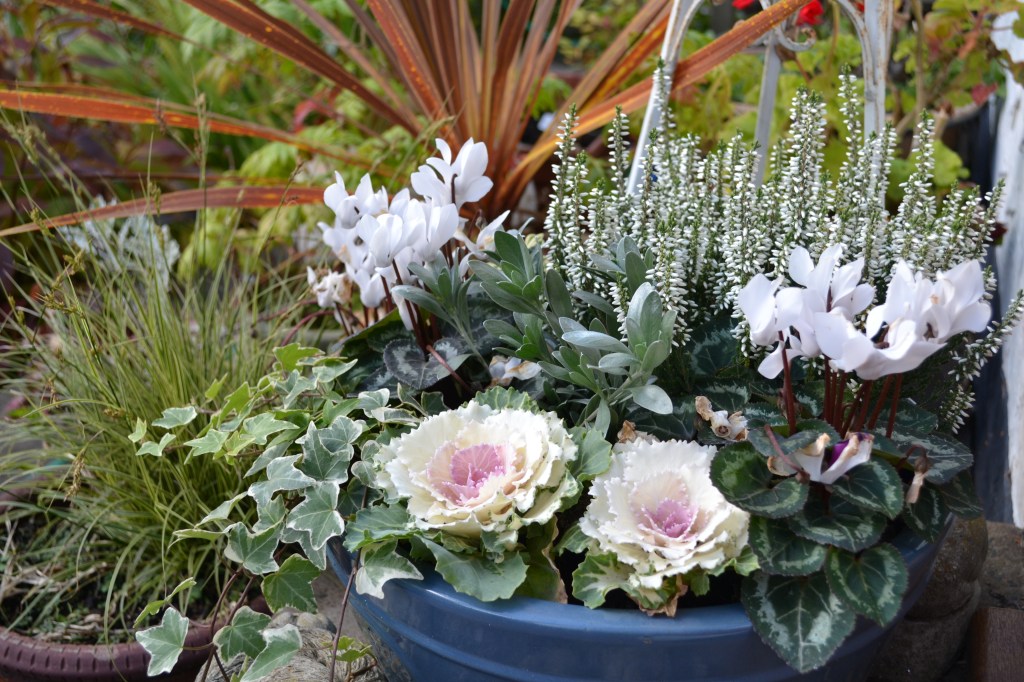I love putting plants together in pots and Autumn is probably my favourite time for doing so – there’s less choice around and so selection is relatively simple. A well designed Autumn pot or basket is really effective positioned to greet you as you come and go, just at the time garden borders are fading and dying back for winter. Take care with your plant selection and you can expect to enjoy your pots over the winter period too. Over the years (through trial and error!), I’ve collected a few tips for ensuring that my pots are evenly balanced taking into consideration plant colour, foliage, shape and height – and just as important, maintained for longevity.

- Plant Selection
Complementary colour is the obvious factor in plant selection, but when you’re designing for the confined space of a pot, it’s also important to make sure that you select plants with varying height, spread, leaf shape and flowering habit. I like to use a variety of spiky and flat leaved foliage, plants with a trailing habit and a statement specimen. When in the garden centre, I tend to place plants in a test arrangement in the trolley to ensure there are no glaring oddities and that they look good together.

2. Green
Evergreen foliage is a must in an Autumn/Winter pot, but be mindful of the power of the colour green in your pot – the last thing you need is for all plants to have similar leaf colour as this would produce a very flat looking display. However, test potential specimens out to make sure your selections complement rather than clash!

create this green and white themed pot
3. Choosing your Pot
I find that generally pots look more aesthetically balanced when they make up half the finished height when fully planted, but this is probably due to my own design limitations. My personal shape preference is for a pot with a wider rim than base to ease the flow of trailing plants over the edge and don’t forget that the colour of the pot is also important when marrying up with the plants.

4. Positioning
When deciding where each plant it to be positioned in its container, I tend to place them in and around the pot until I’m satisfied with the design – before adding any compost. Whilst care needs to be taken to avoid overcrowding, you really don’t want bare soil showing – again there’s a balance to be achieved. I also take into consideration whether the pot will be seen from all sides or from just one angle – this helps me decide whether to position the tallest plant at the back or in the middle of the pot. The remaining specimens are then placed in height order either around or in front of the tallest, finishing with trailers.


5. Compost and drainage
I’ve read a lot of advice on the most suitable medium for plants in pots. I tend to use a multi-purpose compost with John Innes, a scoop of sharp sand and a handful of blood fish and bone in most of my pots, using more sand or even grit for alpines and succulents. For ericaceous plants, I aways use an ericaceous compost mix. In all pots, I place stones/grit in a layer at the bottom of the pot to aid drainage. It’s a good idea to use pot feet to raise the pot off the ground to further assist with drainage in wet weather in Autumn and Winter.
5. Care in Winter
The main threat to your Autumn/Winter pots is over hydration which can cause the roots to rot or freeze – either of which could kill the plants. Make sure the compost doesn’t dry out completely during these months, but be sparing and mindful of rainfall – if there is persistent heavy rain (rather like October and November this year!), consider sheltering the pots from it and use pot feet. Most containers do not require feeding during the winter.
New pots!
This year, I chose a selection of lilac and orangey hues for two pots for the area just outside our new bifold doors: heuchera, imini grass and an orange viola for one pot and lamium, calocephalus, rhodohypoxis, ornamental kale and a lilac viola for the other.
I managed to resist buying new pots – there really was no need at all as I’ve got quite a few languishing empty at the side of the house and so I chose one blue and one terracotta.
I had a gap crying out for a taller plant when the blue pot was done – but soon found a suitable chunk of euphorbia robbiae lurking in the garden, I’ve blogged about invasive plants previously and this is certainly one of them, but contained in a pot it has its uses.


I’m pleased with the results – a lovely view from the comfort of a warm dry room!

These are very pretty! It’s nice you have a mild climate in which to enjoy them. Too cold here. 😉
LikeLike
Thanks! It’s been exceptionally wet here this Autumn – miserable at times!
LikeLiked by 1 person
Love these colour combinations – especially the delicate pink and white in the cyclamen and heather pot. 🙂
LikeLiked by 1 person
Lovely flowers aren’t they!
LikeLiked by 2 people